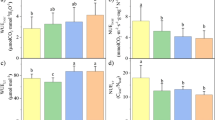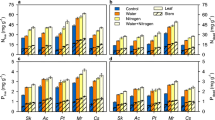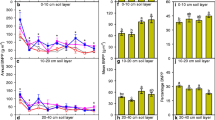Abstract
Productivity of semiarid grasslands is primarily limited by seasonal rainfall amount and becomes increasingly limited by nutrient availability under wet conditions. Interactive effects of water and N availability on grassland productivity and parameters related to water use were studied on a grassland site in Inner Mongolia, China, in a 2-factorial experiment with two levels of water (rainfed: 158 mm; irrigated: 839 (N0) and 972 (N1) mm) and N supply (0 or 180 kg N ha−1). RUE was calculated from ANPP and cumulative water supply. Bare soil evaporation (E) was calculated from climatic data and leaf area dynamics, and percolation (D) and transpiration (T) were estimated with HYDRUS-1D. Water-use efficiency (WUE, ANPP / (T + D)) and transpiration efficiency (TE, ANPP / T) were calculated. Resource availability had pronounced effects on the water-use efficiency of semiarid grassland. RUE, WUE, and TE all decreased under irrigated compared to rainfed conditions and were significantly increased with N fertilizer application at both levels of water supply. While the irrigation effect on parameters of water-use efficiency were accordingly reflected in stable carbon isotope signatures, N supply resulted in significantly less negative δ13C-values under rainfed but not irrigated conditions. It is concluded, that spatial or temporal gradients in resource availability have pronounced effects on the water-use efficiency of semiarid grassland. The decrease of water use-efficiency under high water supply was related to differences in TE and not to a relative increase of unproductive water loss. Carbon isotope discrimination was highly correlated with WUE and TE, but can be a poor predictor of RUE.





Similar content being viewed by others
References
Austin AT, Yahdjian L, Stark JM, Belnap J, Porporato A, Norton U, Ravetta DA, Schaeffer SM (2004) Water pulses and biogeochemical cycles in arid and semiarid ecosystems. Oecologia 141:221–235
Bacon MA (2004) Water use efficiency in plant biology. Blackwell, Oxford
Bai YF, Han XG, Wu JG, Chen ZZ, Li LH (2004) Ecosystem stability and compensatory effects in the Inner Mongolia grassland. Nature 431:181–184
Bai YF, Wu JG, Xing Q, Pan QM, Huang JH, Yang DL, Han XG (2008) Primary production and rain use efficiency across a precipitation gradient on the Mongolia Plateau. Ecology 89:2140–2153
Bolger TP, Turner NC (1999) Water-use efficiency and water-use of Mediterranean annual pastures in southern Australia. Aust J Agr Res 50:1035–1046
Brueck H (2008) Effects of nitrogen supply on water-use efficiency of higher plants. J Plant Nutr Soil Sci 171:210–219
Burke IC, Lauenroth WK, Parton WJ (1997) Regional and temporal variation in net primary production and nitrogen mineralization in grasslands. Ecology 78:1330–1340
Ehleringer JR (2001) Productivity of deserts. In: Roy J, Saugier B, Mooney HA (eds) Terrestrial global productivity. Academic, San Diego, pp 345–362
Epstein HE, Lauenroth WK, Burke IC, Coffin DP (1996) Ecological responses of dominant grasses along two climatic gradients in the Great Plains of the United States. J Veg Sci 7:777–788
Feddes RA, Kowalik PJ, Zaradny H (1978) Simulation of field water use and crop yield. Wiley and Sons, New York
Gao Y (2007) Influences of different land use management on the net primary productivity and belowground carbon allocation in a semi-arid Inner Mongolia steppe. PhD thesis, University of Kiel, Germany
Gao YZ, Giese M, Han XG, Wang DL, Zhou ZY, Brueck H, Lin S, Taube F (2009) Land use and drought interactively affect interspecific competition and species diversity at the local scale in a semiarid steppe ecosystem. Ecol Res. doi:10.1007/s11284-008-0532-y
Hill MJ, Donald GE, Vickery PJ, Moore AD, Donnelly JR (1999) Combining satellite data with a simulation model to describe spatial variability in pasture growth at a farm scale. Aust J Exp Agr 39:285–300
Hooper DU, Johnson L (1999) Nitrogen limitation in dryland ecosystems: responses to geographical and temporal variation in precipitation. Biogeochemistry 46:247–293
Huxman TE, Smith MD, Fay PA, Knapp AK, Shaw MR, Loik ME, Smith SD, Tissue DT, Zak JC, Weltzin JF, Pockman WT, Sala OE, Haddad BM, Harte J, Koch GW, Schwinning S, Small EE, Williams DG (2004) Convergence across biomes to a common rain-use efficiency. Nature 429:651–654
Jones HG (1992) Plants and microclimate: a quantitative approach to environmental plant physiology. Cambridge University Press, Cambridge CB2 1RP
Kang L, Han X, Zhang Z, Sun OJ (2007) Grassland ecosystems in China: review of current knowledge and research advancement. Phil Trans R Soc B 352:997–1008
Kimura R, Fan J, Zhang X, Takayama N, Kamichika M, Matsuoka N (2006) Evapotranspiration over the grassland fields in the Liudaogou Basin over the Loess Plateau, China. Acta Oecol 29:45–53
Knapp AK, Briggs JM, Koelliker JK (2001) Frequency and extent of water limitation to primary production in a mesic temperate grassland. Ecosystems 4:19–28
Lauenroth WK, Dodd JL, Sims PL (1978) Effects of water induced and nitrogen induced stresses on plant community structure in a semi-arid grassland. Oecologia 36:211–222
Le Houréou HN (1984) Rain use efficiency: a unifying concept in arid-land ecology. J Arid Environ 7:213–247
Monteith JL (1973) Principles of environmental physics. Edward Arnold, Whistable Litho Ltd., Kent, Great Britain.
Paruelo JM, Lauenroth WK, Burke IC, Sala OE (1999) Grassland precipitation-use efficiency varies across a resource gradient. Ecosystems 2:64–68
Ritchie JT (1972) Model for predicting evaporation from a row crop with incomplete cover. Water Resource Res 8:1204–1213
Sala OE, Parton WJ, Joyce LA, Lauenroth WK (1988) Primary production of the central grasslands region of the United States. Ecol 69:40–45
Sims PL, Singh JS (1978) The structure and function of ten western North American grasslands. III. Net primary production, turnover and efficiencies of energy capture and water-use. J Ecol 66:573–597
Šimůnek J, Sejna M, van Genuchten MT (1998) The HYDRUS-1D software package for simulating the one dimensional movement of water, heat, and multiple solutes in variably-saturated media. Version 2.0. IGWMC-TPS-70. Int. GroundWater Modeling Center, Colorado School of Mines, Golden.
Snyman HA (1999) Short-term effects of soil-water, defoliation and rangeland condition on productivity of a semi-arid rangeland in South Africa. J Arid Environ 43:47–62
Snyman HA (2002) Short-term responses of rangeland botanical composition and productivity to fertilization (N and P) in a semi-arid climate of South Africa. J Arid Environ 50:167–183
Squire GR, Gregory PJ, Moneith JL, Russell MB, Singh P (1983) Control of Water-use by Pearl Millet (Pennisetum Typhoides). Exp Agr 20:135–149
Steffens M, Kölbl A, Totsche KU, Kögel-Knabner I (2008) Grazing effects on soil chemical and physical properties in a semiarid steppe of Inner Mongolia (P.R. China). Geoderma 143:63–72
Verón SR, Oesterheld M, Paruelo JM (2005) Production as a function of resource availability: slopes and efficiencies are different. J Veg Sci 16:351–354
Wesseling JG (1991) Meerjarige simulaties van grondwateronttrekking voor verschillende bodemprofielen, grondwatertrappen en gewassen met het model SWATRE, Report 152. Wageningen, Winand Staring Centre
Xiao X, Wang Y, Jiang S, Ojima DS, Bonham CD (1995) Interannual variation in the climate and above-ground biomass of Leymus chinense steppe and Stipa grandis steppe in the Xilin river basin, Inner Mongolia, China. J Arid Environ 31:283–299
Yuan ZY, Li LH, Han XG, Chen SP, Wang ZW, Chen QS, Bai WM (2006) Nitrogen response efficiency increased monotonically with decreasing soil resource availability: a case study from a semiard grassland in northern China. Oecologia 148:564–572
Zhao Y, Peth S, Krümmelbein J, Horn R, Wang Z, Steffens M, Hoffmann C, Peng X (2007) Spatial variability of soil properties affected by grazing intensity in Inner Mongolia grassland. Ecol Model 205:241–254
Acknowledgements
This work was supported by the Deutsche Forschungsgemeinschaft (DFG, SA 359/30-1) and embedded into the joint-research project FG 536, MAGIM. We would like to thank IMGERS meteorological station for providing climatic data.
Author information
Authors and Affiliations
Corresponding author
Additional information
Responsible Editor: Tibor Kalapos.
Rights and permissions
About this article
Cite this article
Brueck, H., Erdle, K., Gao, Y. et al. Effects of N and water supply on water use-efficiency of a semiarid grassland in Inner Mongolia. Plant Soil 328, 495–505 (2010). https://doi.org/10.1007/s11104-009-0128-5
Received:
Accepted:
Published:
Issue Date:
DOI: https://doi.org/10.1007/s11104-009-0128-5




